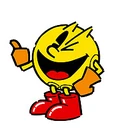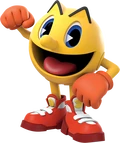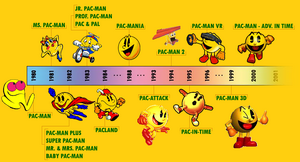- For other uses of Pac-Man, see Pac-Man (disambiguation).
The series' logo.

U.S. logo
The Pac-Man series is a media franchise originally created by Namco, starring the fictional character Pac-Man. The series is primarily comprised of video games, the first of which released in 1980.
History[]
Creation[]
Pac-Man's origin is a confusing mystery, with multiple unique claims that contradict each other, neither of which can be 100% proven true or false.
Pac-Man's first appearance was not in the original arcade game; unknown to many, the series originated as a line of toys by Tomy in 1974, six years prior to the game. The first of these was a toy bank, in which Pac-Man (also referred to as "Je Je" on some models) would munch down coins by flipping them into his mouth via a lever. Subsequent toys include a board game and a water game, both of which were released overseas as "Mr. Mouth".

The three Pac-Man toys released in the 1970s
The arcade game, originally called Puckman in Japan, was created by Namco employee Toru Iwatani. Some inspiration was seemingly drawn from the toy line (although the gameplay premise itself was unique), and the actual Japanese katakana (パックマン "Pakkuman") was identical, despite the English reading "Puck" instead of "Pac". After the arcade game's release, Tomy seemed to have worked out a roughly decade-exclusive licensing deal with Namco; this would imply some form of agreement was met between the two, in exchange for Namco acquiring the full Pac-Man character/trademark rights.
Namco, to this day, seems to intentionally not mention the existence of the toy line. According to more commonly cited reports, Pac-Man was based on a pizza with the first quarter of it cut out, which inspired Toru Iwatani to create the character. However, Iwatani himself has stated this claim to be a "half-truth"; with the proper inspiration for Pac-Man being the Japanese kanji for "mouth" (口). As to if Namco's Pac-Man was truly coincidental compared to Tomy's Pac-Man remains unclear; and Iwatani's origin claims cannot be completely disproven.
Arcade game[]

Japanese Pac-Man artwork.
- Main article: Pac-Man (game)
The original Puckman arcade game was released in Japan on May 22, 1980. In the game, the player navigates Pac-Man through a maze to eat all of the dots, while avoiding Ghosts.
As previously stated, the game was called Puckman in English, despite being closer to Pac-Man in Japanese text. By the time it was released in the U.S., the name was altered to the intended Pac-Man name, although this was actually changed due to fear of machine vandalism (changing "P" in "Puck" into an "F").
Toru Iwatani has stated that while developing Puckman, he wanted to create a game that could appeal to women, as most (if not all) arcade games at the time did not. This strategy worked, and Pac-Man attracted both male and female audiences.
Popularity in Japan and overseas[]
Pac-Man had moderate success when the arcade game was initially released in Japan; it was not heavily advertised or well-known, and lagged behind games such as Space Invaders and Galaxian in popularity. However, his debut in America proved widely successful, becoming the most popular video game at the time of its release. The popularity of Pac-Man in America led to a bigger marketing push for the game in Japan, leading to it becoming a big hit in its home region as well. To date, Pac-Man is still the highest-grossing arcade game of all time worldwide.
Midway sequels[]

U.S. Pac-Man artwork.
After the huge success of the first Pac-Man game, the game's U.S. distributor, Bally Midway, made several of their own sequels to Pac-Man. Each title starred a newly-created member of Pac-Man's family. The first game was Ms. Pac-Man, which starred his wife and featured a larger challenge than the previous game. Ms. Pac-Man became an even bigger hit than the original in North America, outselling it by several thousand machines.
Following Ms. Pac-Man's groundbreaking success, Midway created several more Pac-Man titles; these included Jr. Pac-Man, Baby Pac-Man, and Professor Pac-Man, among others. Towards the later 1980s, however, Midway's licensing contract with Namco expired; with Namco forming a proper U.S. branch for future game distribution. The legal rights for the Midway-created sequels (including Ms. Pac-Man) were transferred over to Namco in 1987.
Namco sequels[]
Namco also produced several arcade sequels of their own; these include Super Pac-Man, Pac & Pal, Pac-Land, and Pac-Mania. Pac-Land in particular is considered an influential game from a historical standpoint, being one of the first side-scrolling platformer games.
"World" era[]
Pac-Man reached practically unparalleled fame by the 1990s, with games consistently being released throughout the decade. After numerous other console games, Namco Hometek released Pac-Man World in 1999, a 3D platformer for the PlayStation. The game was very successful, resulting in two sequels.
Throughout the 2000s, many original Pac-Man games continued to be released; including innovative titles like Pac 'n Roll and Pac-Pix. While re-releases of older Pac-Man titles were always prevalent, the amount of them greatly increased towards the later 90s; with numerous compilations, such as the Namco Museum series and Pac-Man Collection, being released.
The "World" era of Pac-Man games (spanning roughly 1999-2006) was largely successful, particularly in North America. However, several proceeding factors would cause this generation of Pac-Man to end somewhat abruptly.
Legal issues and company merge[]
- Main article: History of Ms. Pac-Man legal issues
In the early 2000s, Namco was sued by the former developers from General Computer Corporation; a company who worked with Bally Midway on producing Ms. Pac-Man. In this lawsuit, it was ruled that GCC was owed royalties by Namco for future uses of the Ms. Pac-Man property. Seemingly due to this lawsuit, Namco stopped using Ms. Pac-Man (alongside the other "Midway" Pac-Man games/characters) in most media; which were staples of the Pac-Man series for decades prior.
In 2006, Namco merged with toy company Bandai, forming Namco Bandai Holdings. Bandai Namco would handle the Pac-Man brand somewhat differently than Namco and Namco Hometek before them. One notable Pac-Man release under Bandai Namco's early operation is Pac-Man Championship Edition; which based itself directly off of the original arcade game, with various new twists.
"Ghostly Adventures" era[]

Ghostly Adventures artwork.
At some point following Bandai Namco's formation, a full reboot for the Pac-Man franchise was greenlit. The reboot officially started in 2010, with the announcement of Pac-Man Party and a then-unnamed Pac-Man TV series. Almost every character besides Pac-Man himself were removed, giving him a new cast of friends and updated versions of the Ghosts; likely due to the aforementioned ownership change of Ms. Pac-Man. The new characters were more childlike, and almost none of them were Pac-People.
The animated series was eventually titled Pac-Man and the Ghostly Adventures, first airing in 2013. The show's plot involves a teenage Pac-Man trying to find his parents and bring back the yellow race, which was entirely wiped out by a ghost named Betrayus. The show spawned two video games, simply called Pac-Man and the Ghostly Adventures 1 and 2.
The games released in this era received generally mixed reception; with some of the changes, particularly the lack of longtime classic characters such as Ms. Pac-Man and Professor Pac-Man (though the two would have counterparts in the form of Cylindria and Sir Cumference in the Ghostly Adventures franchise), being criticized by both critics and longtime fans alike. While Pac-Man and the Ghostly Adventures debuted to high ratings, outside of this, the Ghostly Adventures franchise as a whole - arguably the main focus of the reboot - only obtained cult status.
During this same period, Namco released several games based on the "classic" style established by Pac-Man Championship Edition. This includes two direct Championship Edition sequels, C.E. DX and C.E. 2, alongside the mobile game Pac-Man 256. These titles were much more well-received than the Ghostly Adventures media; seemingly because of this, Bandai Namco dropped the "Ghostly Adventures" reboot entirely, and began releasing titles more in line with the Championship Edition series.
Characters[]
Reoccurring[]
- Pac-Man - The main protagonist in most of the Pac-Man games. He is able to eat many large amounts of food at one time.
- Ms. Pac-Man - Pac-Man's spouse. She is often concerned about her husband, and plays the role of a supporting character in most Pac-Man games.
- Jr. Pac-Man - The first-born child of Pac-Man & Ms. Pac-Man.
- Baby Pac-Man - The second-born child of Pac-Man & Ms. Pac-Man.
- Professor Pac-Man - An old, wise man. He knows a lot about the history of Pac-Land and Pac-Land in general.
- Blinky - The red ghost, considered the de facto leader. He sticks close on Pac-Man's tail and always takes the fastest route to him.
- Pinky - The pink ghost. Appears to work in unison with Blinky to ambush Pac-Man.
- Inky - The light blue ghost. Has a unique method of approaching Pac-Man, but may shy away at times.
- Clyde - The orange ghost. Typically depicted as timid and cowardly.
- Sue - The purple ghost. Though not quite as fast as Blinky, she is a lot more aggressive, continuing to chase Pac-Man even after the ghosts reenter "scatter" mode.
- Chomp-Chomp - Pac-Man Family's pet dog.
- Sour Puss - Pac-Man Family's pet cat.
Other[]
- Funky and Spunky - The two commons that appeared in Pac-Mania. They are both able to jump, and the latter can jump higher than Pac-Man, making her a greater potential threat than Funky.
- Kinky - The yellow ghost that only appeared in Pac-Man Arrangement (1996). He can fuse with the other ghosts to make larger, stronger, faster duplicates of them which contain special abilities. Kinky is the only ghost who has shown the ability to do so.
- Spooky - A powerful ghost. He was sealed away years ago by Sir Pac-a-Lot, and later by Pac-Man.
- Miru - Pac-Man's friend. She helps out Pac-Man in Pac & Pal by moving items away from ghosts. She was replaced by Chomp-Chomp in the American release of the game.
- Yum-Yum - The daughter of Blinky who has a romantic relationship with Jr. Pac-Man.
- Pooka - An enemy from the Dig Dug series. He has, somehow, formed a friendship with the Pac-Man family.
Notable Pac-Man Media[]

The growth of the Pac-Man series since its debut in 1980.
Games[]
- Pac-Man (TOMY board game) (1976)
- Pac-Man (arcade game) (1980)
- Pac-Man (Atari 2600 game) (1982)
- Ms. Pac-Man (1982)
- Super Pac-Man (1982)
- Baby Pac-Man (1982)
- Jr. Pac-Man (1983)
- Pac & Pal (1983)
- Pac-Land (1984)
- Pac-Mania (1987)
- Pac-Man Arrangement (1996)
- Pac-Man World (1999)
- Ms. Pac-Man Maze Madness (2000)
- Pac-Man World 2 (2002)
- Pac-Man Vs. (2003)
- Pac-Pix (2005)
- Pac 'n Roll (2005)
- Pac-Man Championship Edition (2007)
- Pac-Man Championship Edition DX (2010)
- Pac-Man 256 (2015)
- Pac-Man 99 (2021)
Television[]
- "Pac-Man" (1982-1984)
- "Pac-Man and the Ghostly Adventures" (2013-2015)
Film[]
- "Wreck-It Ralph" (minor cameo) (2012)
- "Pixels" (major cameo) (2015)
- "Kamen Rider Heisei Generations: Dr. Pac-Man vs. Ex-Aid & Ghost with Legend Riders" (2016)
- "Pac-Man Cinema Manner Movie" (Japanese theatrical short film) (2019)
Additionally, there were several plans to release films directly titled "Pac-Man", starting as early as 1984, but nothing ever came to fruition.
Music[]
- "Pac-Man Fever" (Buckner & Garcia, 1982)
- "Pac-Man" (Beatles "Taxman" parody) ("Weird Al" Yankovic, 1982)
Real World[]
Pac-Man is such a universally known franchise that many real-world objects and events use the term "Pac-Man" in their name, often to coin a comparison with said thing to the video game. These include:
- Pacman frog - Name given to a species of rather round frogs with large mouths. Scientifically referred to as Ceratophrys
- Pacman nebula - A nebula with a Pacman-like appearance. Scientifically referred to as NGC-281
- Pacman octopus - Species of octopi that looks similar to Clyde, the orange Pac-Man ghost. Scientifically referred to as Opisthoteuthis californiana
- Pacman defense - A legal strategy where a smaller company purchases a larger company that is trying to take them over, similar to Pac-Man eating a Power Pellet.
The alias "Pacman" is also used by several athletes, including Manny "Pacman" Pacquiao (boxer) and Adam "Pacman" Jones (football player). Pac-Man has also had countless appearances and references in other media, including appearing on the cover of Time Magazine.[1]

